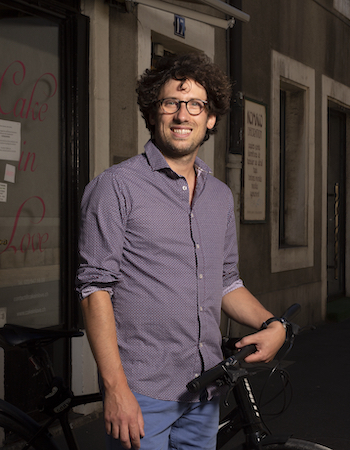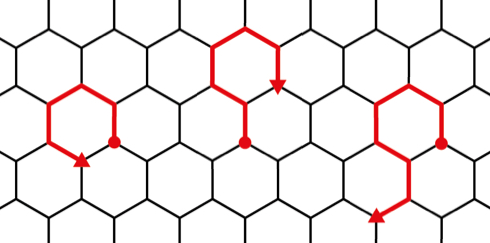

Hugo Duminil-Copin (Photo Matteo Fieni)
This is an easy introduction to the work of Hugo Duminil-Copin, you can read more of the mathematical details in this article.
Hugo Duminil-Copin, a mathematician from the University of Geneva, has won one of this year's Fields Medals at the International Congress of Mathematicians. The Fields Medal is one of the most prestigious prizes in mathematics. It is awarded every four years "to recognise outstanding mathematical achievement for existing work and for the promise of future achievement". Up to four mathematicians up to the age of 40 are awarded a Fields Medal each time.
Phase transitions and universality
Duminil-Copin has been recognised for his work transforming the mathematical theory of phase transitions in statistical physics. Phase transitions are something we're all familiar with – an example is water freezing to ice when it falls below zero degrees temperature. A phase transition is when a complicated system, like a bunch of water molecules, undergoes some drastic change of behaviour as some parameter, in this case temperature, passes some critical point.
"What we do as mathematicians is we try to understand how these phase transitions occur by making mathematical caricatures of the physical phenomenon," says Duminil-Copin. An example of such a mathematical caricature (otherwise known as a mathematical model) is using a regular lattice to describe the arrangement of the system you're trying to understand. In reality there are no real constraints on the positions of the molecules in liquid water, they don't lie regularly in space in a way you could realistically describe using the points on a lattice. But in order to study this system it's often simpler to imagine that the molecules are regularly positioned in this way.
See here for all our coverage of the ICM 2022 and the prizes awarded there.
Although such an assumption is deeply unrealistic, Duminil-Copin says that studying the system this way allows you to explain the phenomena that are actually occurring. "It's something related to a very deep phenomenon – universality – that I try to understand as a mathematician."
Universality is almost like wishful thinking come true: in certain situations the fine details of your mathematical model don't affect its global behaviour. The reason is that if a system involves many different random processes, such as many water molecules moving around, then the details of the underlying mechanisms should not matter. In the example of water freezing to ice, you can choose whatever arrangement of molecules you like – assume they are positioned regularly in a lattice of your choosing – and the phase transition you are studying will have the same properties regardless of your choice of lattice.
"This is very reassuring for mathematicians and physicists because it tells you that many systems in the end have the same behaviour, and you can choose the simplest example of such systems, which is those that lie on a lattice." Mathematically you can get a lot more out of this much simpler description of the problem. The mathematical model isn't necessarily representative of the physical reality, but thanks to universality you're still going to end up with the same results as if you'd started off with a physically accurate description.
Beautiful problems
Statistical physics offers problems that Duminil-Copin is particularly drawn to: ones that are deceptively simple to state but require new mathematics to solve. One example was one of the first conjectures he learned about when he was a postdoctoral student.
"Imagine you are in front of a bee hive," says Duminil-Copin. The front of the beehive forms a hexagonal tiling of the plane, and the corners and lines marking the walls of the beehive form the points and edges of a hexagonal or honeycomb lattice. Imagine you choose a starting point in the lattice and then pick your path across the lattice following one simple rule: you can not return to any place on the lattice you have already been. This is called a self-avoiding walk.

Examples of self-avoiding walks of length 5, 6 and 7. (Image by Charles Trevelyan)
Just how many self-avoiding walks are there? As Duminil-Copin says, the rules are so straightforward a child can do it. There are 3 if your walk is only one step long, 6 if it is two steps long, 12 if it is three steps long. But the complexity of the problem quickly appears with the number of steps taken, and it's increasingly hard to keep track of this number as you try to make sure you never retread your steps. "You realise very quickly that you cannot compute exactly this number, it's a very difficult number to grasp."
In 1980 the statistical physicist Bernard Nienhuis surprised everyone by saying not only was it possible to grasp this number, he gave the answer for how quickly the number of walks grows – conjecturing that the rate of growth of the number of self-avoiding walks of length $n$ steps grows at the rate of almost $(\sqrt{2+\sqrt{2}})^n$.
"I found it truly fantastic that there is an answer, and it's a really cool number!" Duminil-Copin says. "This was a conjecture I first learned about in my masters class. It's funny because at the time it looked like there was no hope the conjecture could be proved." But prove it he did, by using work he was doing on a seemingly disconnected area of maths. "This is a typical example of problems that we have in our field where you get inspired by many other fields of mathematics and physics. It puts you at the crossroads of many places [and] that is something I like very much."
And this problem isn't just interesting to mathematicians. In the 1940s chemists Paul Flory (who won the Nobel Prize for Chemistry in 1974) and W.J.C. Orr introduced self-avoiding walks as a way to study long chain-like molecules – polymers – and understand how they behave. "It's very related to physical phenomena, for example trying to understand what polymers, such as DNA molecules, are doing. These polymers are self-avoiding [walks] for obvious reasons: they are long sequences of molecules that can't be at the same place."
Duminil-Copin sees his Fields Medal as recognition for all of those working in his area and the work they are developing together, and he cannot wait to finally share this recognition with his collaborators when the prizes are announced at the ICM. "Mathematics is a very social activity, much more than people believe" he says. "There is this image of the mathematician as the lonely hero, but in my case it's not a vision of my mathematics or my way of doing mathematics. My work would not happen without this interaction with others." Congratulations to Duminil-Copin and to all his collaborators on this prize!
About this article
Marianne Freiberger and Rachel Thomas, Editors of Plus, interviewed Hugo Duminil-Copin in June 2022.This content was produced as part of our collaborations with the London Mathematical Society and the the Isaac Newton Institute for Mathematical Sciences. You can find all our content on the 2022 International Congress of Mathematicians here.

